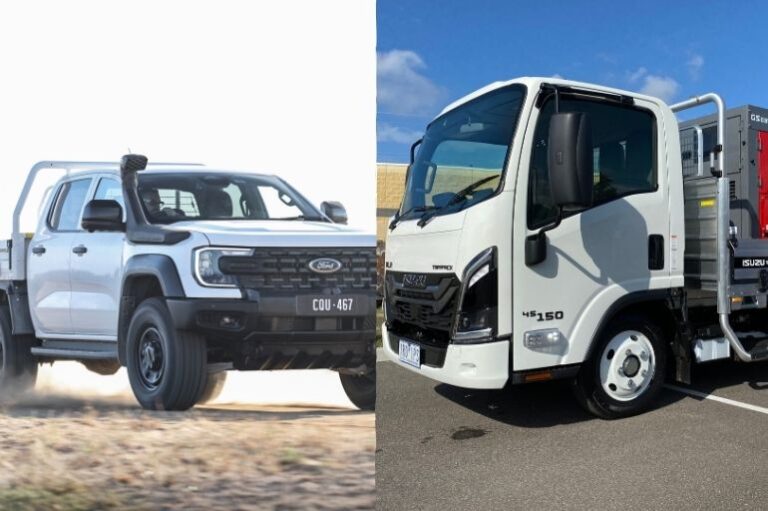Something seismic is happening in the Australian vehicle market. The line that once clearly separated utes and light-duty trucks has not just blurred—it’s been all but erased. The catalyst? A head-on collision between two of the market’s biggest players: Ford and Isuzu. In April 2025, both revealed new vehicles that fundamentally reshape the landscape for fleet managers—and could redefine what it means to choose “fit for purpose.”
Let’s break it down. On one side, you’ve got the new Ford Ranger Super Duty—a behemoth with the skin of a ute and the guts of a truck. On the other side, Isuzu has flipped the script with its new range of light trucks, engineered to handle like an ute while delivering truck-level payload, comfort and safety. It’s ute vs truck in a battle for your fleet garage.
Why It Matters
Historically, fleet buyers have been forced to compromise. Want a ute’s agility and footprint? Say goodbye to serious towing. Need to haul and tow like a boss? You’re climbing into a small truck, sacrificing comfort and daily drivability. Not anymore.
Thanks to technological advancements and fleet feedback, both Ford and Isuzu are tearing up the old playbook. For the first time ever, fleet managers are being offered vehicles that combine the best of both worlds. And it’s going to force some tough decisions.
Ford Ranger Super Duty: The Ute That Ate a Truck
Ford’s answer to the payload paradox is simple: build a ute that behaves like a truck. Enter the Ranger Super Duty, boasting a 4,500kg GVM and 8,000kg GCM. It’s been beefed up in all the right places—chassis, axles, suspension—and matched with smart refinements like a larger fuel tank and improved driveline components. All this, while keeping the familiar Ranger body style that fleets love.
For many fleets, the Super Duty is the holy grail: the form factor of a ute with the muscle of a light truck. It addresses the demand for more capability without stepping up to a truck licence—a game changer in a tight labour market where fewer people are qualified or willing to drive traditional trucks.
Isuzu’s Counterpunch: The Truck That Drives Like a Ute
Isuzu Trucks—long dominant in the light-duty truck space—isn’t backing down. Instead, they’re flipping the script, designing a truck that offers agility and comfort while still delivering truck-level durability.
Their new NLR and NKR models feature:
- Coil spring suspension
- Rack and pinion steering
- Car-like cabin comfort
- Tight turning circles
- Advanced safety tech, including adaptive cruise, keyless entry, auto park brake and more
In short, Isuzu has taken the DNA of the D-MAX and MU-X and grafted it onto a light truck chassis. The result? A vehicle that can work hard and drive soft.
And yes—fleet buyers take note—these trucks can still be driven on a car licence.
The Battle Lines Are Drawn
Fleet buyers now face a more interesting—and challenging—choice than ever before.
- Want a dual cab with brand familiarity and strong resale value? The Ranger Super Duty ticks that box.
- Need maximum payload, rugged durability, and serious safety? Isuzu’s truck offerings now meet the brief without sacrificing comfort.
- Worried about driver shortages or licence restrictions? Both options work within the car licence category.
- Looking to satisfy chain of responsibility and WHS obligations? Both are raising the bar in workplace safety features.
In many ways, 2026 will be the battleground year, as both these vehicles become widely available. Ford’s Super Duty will land just as Isuzu’s full next-gen lineup hits the streets. These aren’t niche products—they’re the flagships from two market leaders converging on the same customer.
So, Who Wins?
Honestly? The fleet buyer.
This isn’t a question of which brand wins—it’s about which vehicle fits your purpose. For utilities, councils, tradies, mining operations, and civil contractors, the convergence of utes and light trucks means you no longer need to settle. You can choose the right footprint, right comfort level, and right GVM for the job—without giving up safety or practicality.
But this also means doing your homework is more critical than ever. You’ll need to:
- Reassess your load and towing needs
- Consider duty cycles and usage patterns
- Factor in total cost of ownership, especially around maintenance and resale
- Think about driver comfort and the impact on retention
Final Thoughts: Truck in a Ute, or Ute in a Truck?
The ute-truck convergence is more than a battle of specs—it’s a reflection of where Australian fleets are heading. We’re seeing the rise of the “Swiss Army Knife” vehicle: capable, comfortable, safe, and fit-for-purpose across a broad range of tasks.
And whether you lean Ford or Isuzu, 2026 will be the year you get to choose a side—armed with more options than ever.
At Fleet News Group, we’ll keep you in the loop and help guide you through this new frontier. Because in a world where your ute could be a truck and your truck could drive like a ute, making the right call has never mattered more.







